Lease IP Addresses To Evade Email Blocking List
Your A to Z guide on email blocking lists, how they work, the common reasons for blocklisting and top solutions to prevent it.
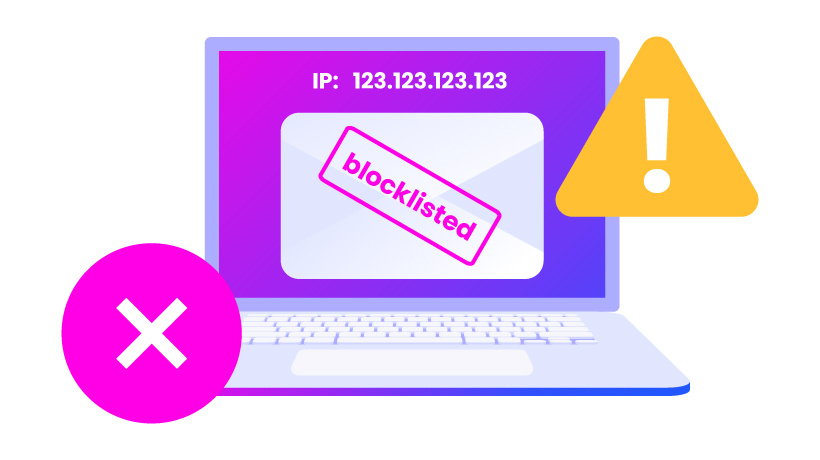
Some emails never make it to the sender. The cause behind email delivery issues can be as simple as a full recipient’s mailbox or a typo in their email address. Unfortunately, more unpleasant scenarios exist. For example, your email address, Internet Protocol (IP) address or domain could have ended up on an email blocking list. To prevent this from happening, it is crucial to know how to maintain a good IP reputation.
Continue reading further to learn what an email blocklist is, what the reasons for being blocklisted are and how to work around it.
Key takeaways
- Three specific reasons determine email blocklisting: spam, high sending volumes and invalid email address targeting.
- Maintaining a good email sender reputation is easier if you use a dedicated IP address.
- IP address leasing is a cost-efficient and quick solution for email marketers to acquire dedicated IPs and take full control over maintaining IP reputation and avoiding blocklists.
Email blocklist explained
An email blocklist is a real-time database that protects users from malicious content and lower the volume of spam emails. It can also be called a blacklist, disallow lists or denylist. We have adopted the term blocklist due to its accuracy.
Email blocklists record IP addresses, domains or email addresses related to suspicious activity:
- IP address is a numeric/alphanumeric label that identifies internet-connected devices
- Domain represents the name of a mailbox from which the emails are sent
- Email address is an identifier for a specific mailbox
Email service providers (ESPs) and internet service providers (ISPs) create email blocklists. When email servers are suspected of sending unwanted or malicious content, ESPs and ISPs begin blocklisting either the IP or the domain name. Once an IP address or domain is blocked, associated emails end up in the receiver’s Spam/Junk folder.
Email blocklisting falls into two categories: IP address-based blocklists and domain-based blocklists.
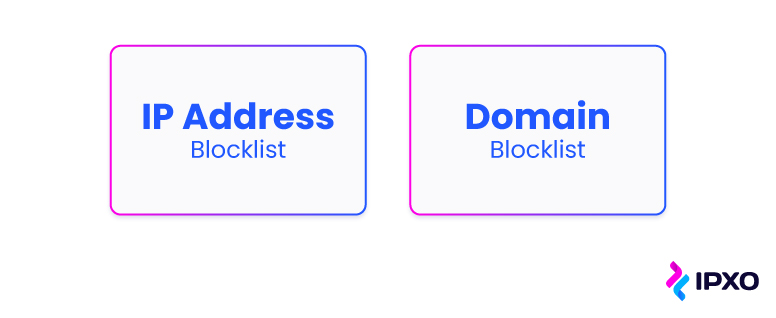
IP address-based blocklists
The credibility of an IP address can either increase or decrease, depending on its holder’s actions. Blocklisting affects IP reputation negatively, diminishing its quality and legitimacy.
In other words, if, due to blocklisting, your mail server’ IP address reputation has become poor, your actions are equated to those of cybercriminals. Thus, even if you wanted to send messages with good intentions, they would not reach the intended recipient’s inbox.
Domain-based blocklists
The emails you send have domains connected to them. If they are blocklisted, the sent emails are blocked. If you are unsure about your domain’s reputation, you can use trusted online tools that track spam sources (e.g., MXToolBox or Spamhaus) to check if your mail server IP or domain name has been included in the list.
Overall, there are a few common types of email blocklists:
- Enterprise spam firewalls enable corporate IP departments to identify spam sources
- Private/Internal blocklists are blocklists that ISPs maintain privately
- Public blocklists are free and allow anyone to check whether IPs or domains are blocklisted
Reasons IP addresses get blocklisted
It is always a good idea to abide by the best email deliverability practices to maintain the health of both your email marketing performance and your brand reputation. However, if you keep receiving bounced emails to your return path (return address), if you send emails to unsubscribed users or get a sudden surge in spam complaints, there is a big possibility that you have been blocklisted. Here are the main causes that lead to blocklists.
Spam
Every email service provider aims to guarantee a smooth experience for its users. However, for an email marketer, it is crucial to get the messages past spam filters. Before the message even reaches the addressee’s inbox, it is examined by anti-spam software and filters. These are built into the systems of email clients, such as Gmail, Yahoo, Outlook and others, and internet service providers, including AT&T, Xfinity or Verizon.
The filters search for such red flags as an excessive amount of images inside the message, spam words in subject lines, shortened URLs, overload of grammatical errors and similarly suspicious elements. Where the email comes from and where it is going also matters.
Of course, if a number of users flag an email received from a specific IP address as spam, it is likely that the service will add it to a spam emails list and block the address.
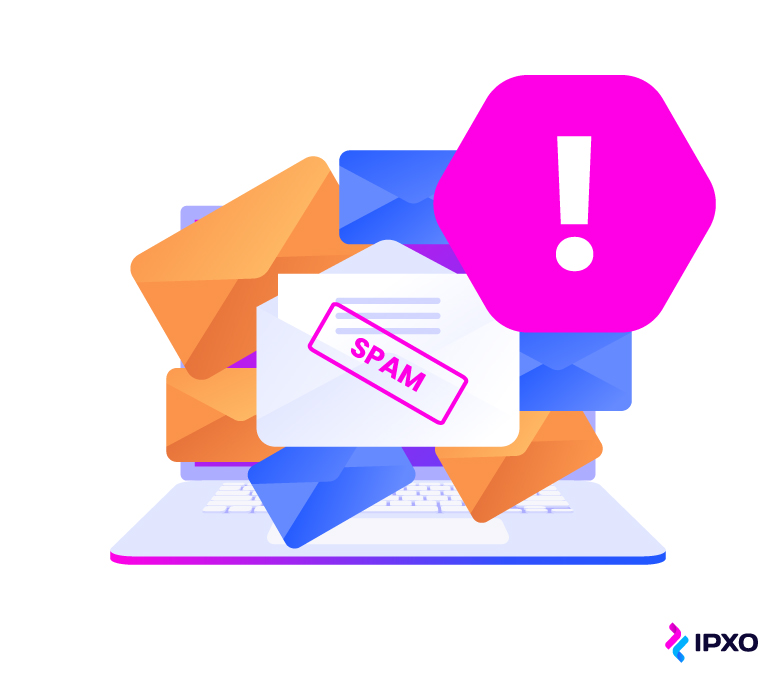
High sending volumes
Sending an excessive amount of emails is a common mistake, especially among beginners. There’s no clear answer as to how many emails you can send without getting blocklisted, mainly because each blocklist has its own rules. Nonetheless, if you normally send up to a hundred emails per week and, all of a sudden, this number skyrockets to a thousand emails per day, your service provider may assume you are sending spam.
To mailbox providers, a high sending volume is a sign that you may have acquired an email list from an external source instead of building it up yourself. Due to this, your email address can be blocked from sending spam or any other kind of mail. Thus, it is advisable to increase the volume of sent emails gradually, over a period of weeks or even months.
Of course, you might send a lot of emails by mistake. That might happen if, for example, you update your database or suffer a cyberattack. The only option in this situation is to stop emailing activity entirely. Then, get in touch with the spam list administrators and fix the blocklisting issue. Once the issue is resolved, you should be automatically removed from the blocklist database.

Targeting invalid emails
Reviewing your contact list from time to time and removing bounced email addresses is important. That is essential because unresponsive, inactive or temporary email addresses may be spam traps that decrease email open rates.
A spam trap is an inactive email address purposely left out in the open by an ISP. Spam traps usually fall into three groups.
- Pure spam traps: Fake addresses embedded into websites to trap spammers
- Recycled spam traps: Email addresses and domain names that still exist but are no longer used and were repurposed into spam traps (e.g., [email protected])
- Typo spam traps: Email addresses with errors (e.g., gmil.com instead of gmail.com, the real Gmail domain), which means sent messages never reach their destination
If you don’t monitor your data and keep sending emails to inactive addresses that either are fake or don’t exist anymore, it can ruin your sender’s reputation.
To increase email open rates, maintain your email list according to best practices. For example, employ the double opt in practice, where new subscribers need to click a link in a welcome email to confirm they want to join a marketing email list. Also, always provide subscribers with a clear opt out of email list option.

How to work around blocklists
It is easiest to keep the sender’s reputation high by avoiding activities that could lead to a blocklist. A good reputation is like playing a game where you need to collect points: The more you gain, the closer you get to the goal.
Therefore, following the rules suggested by email providers and internet service providers is key to good email delivery. Let’s get a better understanding of this.
Email sender reputation upkeep
Your email reputation depends on two factors that are weighed by email providers’ algorithms: domain reputation and IP reputation. A new IP address or a completely new domain won’t have a reputation right away. That is why it is important to keep in mind the red flags we have already mentioned while sending emails in an orderly manner.
Note that domain reputation is closely associated with the sender’s identity. Maintaining a good domain reputation ensures that inboxes like Gmail, Yahoo Mail and Outlook don’t label your emails as spam.
IP reputation, on the other hand, is more related to a computing device from which mail is sent. IP reputation can vary depending on a few factors: Whether it’s new, shared with others or allocated to you personally.
Chances of email blocklisting reduce immensely when the IP address is not shared among hundreds of users. Thus, investing in a dedicated IP address is advisable.
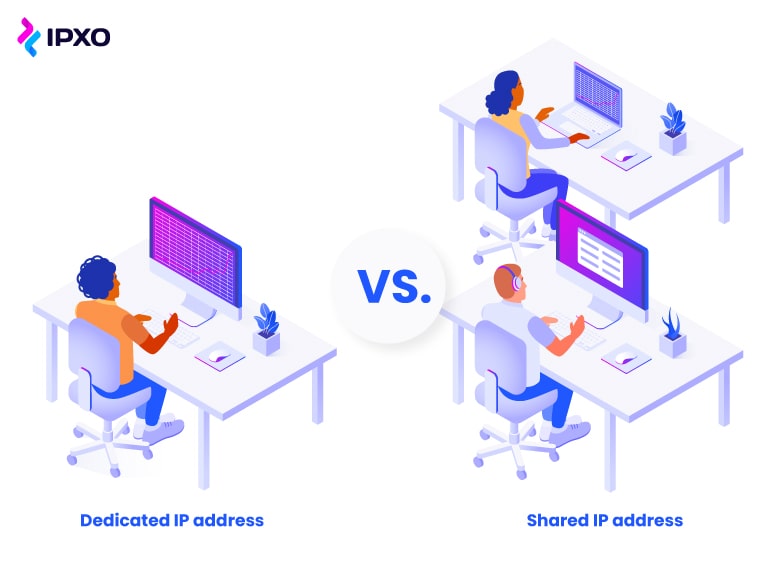
Dedicated IP address for every user
IP addresses on a network can be shared. ISPs and hosting companies connect two or more websites under the same IP address to help save money and resources. This is especially important in the wake of IPv4 resource exhaustion.
However, if you choose to use a shared IP address, its reputation is as much in the hands of other email senders as yours. Thus, malicious actions of other users can lead to blocklisting. For this reason, shared IPs’ reputation is often at a greater risk of being poor.
Meanwhile, only you use a dedicated IP address. The top benefits of using a dedicated IP address include:
- More safety due to an isolated environment
- Full control of IP address reputation and increased protection against blocklisting
- More control over your server setup
- Better user experience and performance because of reduced site loading time
Whether or not you invest in dedicated IPs depends entirely on your business needs. Yet, if you are an email marketer, the advantages are quite obvious. Let’s discuss how to get dedicated IPs.
IP leasing for email marketing
The IPv4 address pool was exhausted over a decade ago. As a direct result of that, today, there are only a few options when it comes to acquiring IPv4 addresses for your business: Join a waiting list, buy IPv4 or lease IPv4.
IP leasing is a lease agreement-based allocation of IPv4 addresses that can positively impact your email marketing efforts. Reliable leasing providers take good care of the digital resources by upkeeping their reputation and screening the blocklists. Usually, IP reputation issues are taken care of before the assets are even offered on the market.
The IPXO Marketplace, for example, not only screens the resources before they are leased but also conducts daily check-ups and IP reputation monitoring during the entire lease period.
Undeniably, leasing is the fastest way to obtain IPs. Instead of waiting weeks or months, you can lease in just a few days. Moreover, once you decide to lease, you have the freedom to choose from a variety of subnets from all five Regional Internet Registries. You also can choose the preferred lease time.
Most importantly, leasing IPv4 addresses is more cost-efficient than purchasing them. Whereas you might have to pay $60 per a single IP address, you only need to pay $0.50 per month on average to lease the same resource.
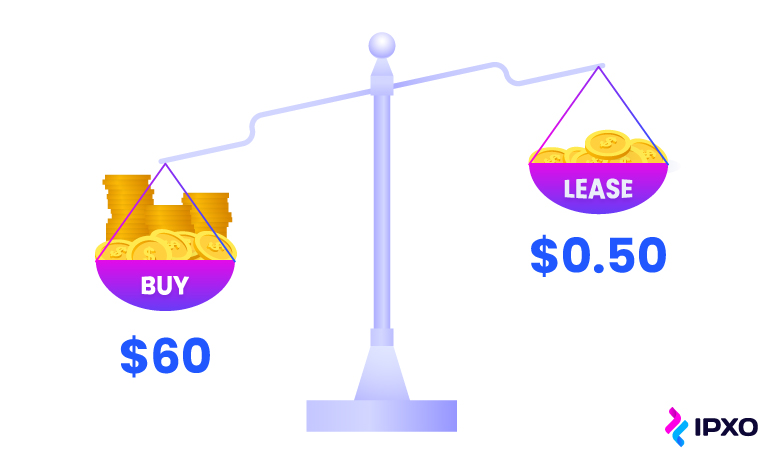
IP leasing provides access to dedicated IPs, which, as you now know, can help you minimize the risks of blocklisting. When you have a dedicated IP address, it’s up to you to build up and upkeep its reputation. Undoubtedly, if you follow the best emailing practices, your marketing emails will reach the intended recipient’s inbox, and you will not need to fear blocklists.
Conclusion
Email block lists have two sides. On one side, they are meant to protect regular email users from unwanted emails. On the other, they help impose restrictions on email marketers.
The best way to make sure that the emails you send reach their destination is to keep in mind the guidelines of ethical email marketing and to take care of IP address reputation. Since the latter is like a digital signature, you should never overlook its importance.
There is a significant difference between using a shared and a dedicated IP address. A shared IP address will remain clean only if all parties abide by good emailing practices. If a single party starts veering off the track, that can harm everyone else. On the other hand, if you use a dedicated IP, you are in full control over that IP’s credibility and your sender’s reputation.
The IPXO Marketplace provides access to a dedicated IP address pool so you can take the reins of your email sender’s reputation. Join the platform for free and enjoy an array of benefits ranging from rich subnet availability and lease flexibility, to professional IP address monitoring and IP reputation upkeep.
Would you like to learn more about IP leasing? Book a demo, and we will demonstrate how you can acquire the IP resources you need in the most cost-efficient way.
About the author
Table of contents
Key takeaways
Email blocklist explained
IP address-based blocklists
Domain-based blocklists
Reasons IP addresses get blocklisted
Spam
High sending volumes
Targeting invalid emails
How to work around blocklists
Email sender reputation upkeep
Dedicated IP address for every user
IP leasing for email marketing
Conclusion
Related reading

The Rising Value of IP Addresses as a Global Commodity
The interaction between IP address sale prices and the broader economic landscape not only emphasizes the perceived financial value of these digital assets but also uncovers a link between…
Read more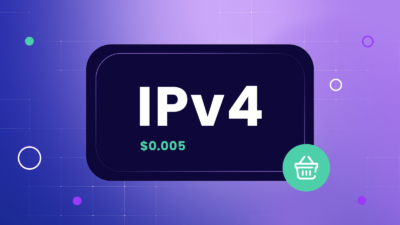
Opinion: AWS Sets the ROI Benchmark for IP Addresses
Explore the significance of Amazon Web Service's new IPv4 pricing model - a paradigm shift in IP address leasing rates.
Read more
Industrial Internet of Things: Use Cases and IPv4 Addressing Challenges
Explore the promising trajectory of the Industrial Internet of Things (IIoT) and the vital IPv4-IPv6 transition for ensuring sustainable innovation.
Read moreSubscribe to the IPXO email and don’t miss any news!
